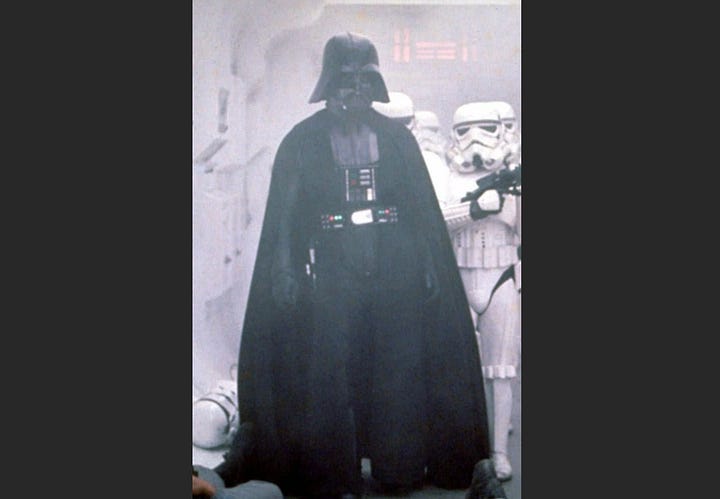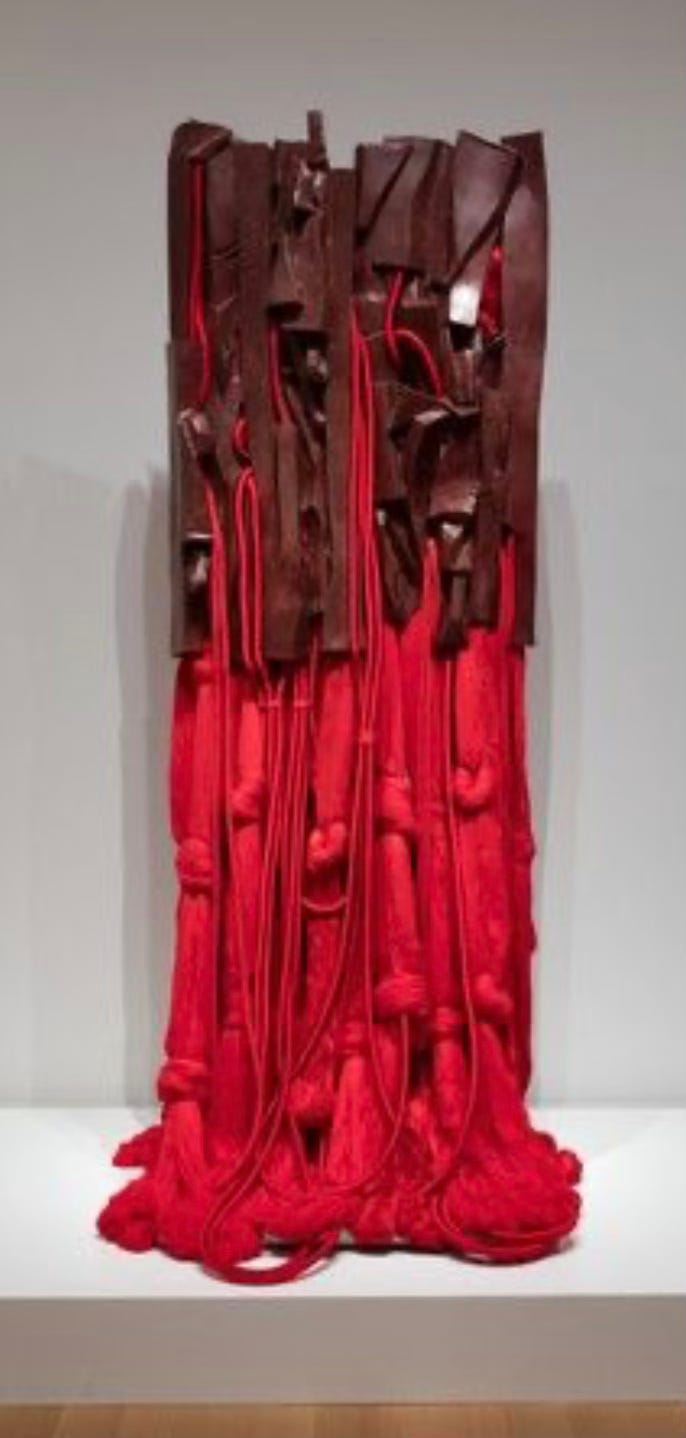Malcolm X #16 by Barbara Chase-Riboud
Power, contrast-clash, and texture by an artist of extraordinarily wide-ranging creativity.
In May last year I returned to the East Coast for a too-short, much-needed, kid-free vacation to visit New Haven friends and old favorite places, like The Place in Guilford, Atticus Books, the food trucks at the medical school, etc. and marveled at how much more full the trees had become on the green in the decade since I moved away. It was so great to visit the Yale University Art Gallery, and remember how lucky I was that this was once my teaching museum—I have led college students, friends, and even groups of toddlers through this museum. I used to just wander in when I needed a quiet moment to turn towards artwork—and really world-class art, from all over the world, available for FREE, every day except Monday. Amazing!
Returning to the YUAG was like visiting old friends, artwork I had walked past dozens of times…but all of a sudden, in the Modern and Contemporary galleries, I saw a new artwork that absolutely stopped me in my tracks. I think I gasped an audible wow, I was so astounded. At almost eight feet tall, in reddish bronze over a cascade of bright red textile-ropes, this sculpture radiates power and magnificence. I knew these galleries well, but I had never seen this one before: it was a new acquisition by the YUAG since my move away, and this was an unforgettable encounter. Have you had a similar moment of astonishment at an artwork? Tell me about it in the comments!
Figure 1. Barbara Chase-Riboud (American, born 1939), Malcolm X #16 (2016), Bronze with red patina, silk, wool, polished cotton and synthetic fibers with a steel support, 92 × 32 × 30 in. (233.7 × 81.3 × 76.2 cm). Yale University Art Gallery, New Haven.
The work that so astounded me is titled Malcolm X #16 by Barbara Chase-Riboud. The first qualities that drew me towards this sculpture were its totemic monumentality and the intense dissonance between the two reds, the duller red of the bronze above and the bright, true red of the many types of textures, fabrics, and yarns below. As I looked more closely, I was equally impressed by its immaculate construction and precision of its fabrication.
The supporting structure of the work is hidden—it rises against the supporting wall, in a way like Brenda Mallory’s Reformed Spools in my post dated August 23, 2024 but on a scale more like a monument than a painting. At the top, slabs of bronze fold and curlicue over and around each other, providing an exoskeleton out of which the ropes fall, knot, and pool at the floor. One approaches this artwork as though a monarch in a throne room. I think its placement against a wall contributes to its monumentality because it is frontal, not a sculpture in the round. The work is a study in both widely differing and carefully close contrasts, which is a major part of the appeal. The bronze contrasts starkly against the woven fibers below, and the two reds jar the eye in a close contrast of color. The bronze at the top calls to mind adjectives like hard, metallic, permanent, monumental, sculptural, architectural, and strong. The frontality, proportions, and the uprightness of the work evoke the human form, albeit at a giant scale: the bronze slabs are like squared shoulders from which the textile skeins cascade like a cape. These woven fibers make us think of opposite adjectives, like soft, tactile, impermanent, flowing, clothing, gathered, playful, and lithe. The skeins are woven or gathered into falling ropes, knotted and bunched, like a waterfall plunging through and over rocks; also like a waterfall or a long cape, the skeins pool at the floor of their pedestal. This widening as they meet the floor provides a sense of stability, like the widening of the base of a tree’s trunk, to counter-balance the strength of the bronze at the sculpture’s top. They also serve to cover the structural support of the heavy bronze, as a type of “skirt” as Chase-Riboud explains in an interview (video linked below).
Of course, it is the clash of the bronze’s red with the textiles’ red that compels the viewer—and this particular viewer’s favorite color is red, so I admit a certain bias. I remember the red of the bronze being brighter than this image taken from the YUAG website, but dull compared to the brightness of the skeins below. Although these skeins, ropes, and woven textiles were made of a variety of materials, silk, wool, polished cotton, and synthetic fibers—they all match in the same intense red. This vibrant firetruck red juxtaposed with the duller brick red of the bronze was a pleasant but jarring aesthetic experience, and in my notes I used what must be an invented word to describe it: “frission” —a combination of frisson (getting goosebumps or chills from an aesthetic experience), fission (a collision of atomic particles to create a huge amount of energy), and friction (the resistant force of two materials rubbing together to produce warmth). This intense “frission” rose between the two close but clashing colors, amplified by the utterly different textures between bronze and rope.
As I read for more background, I found Barbara Chase-Riboud to be among the most versatile artists alive today. She’s a creative force, not only in sculpture and drawing but also as a poet and novelist. The first woman of color to graduate with an MFA from Yale, she has won prizes not only for her artwork but also for her writing, including for a novel on Sally Hemings, and Hemings’ relationship with Thomas Jefferson. Within my lifetime that issue has gone from fringe belief to mainstream acceptance, and her work was crucial to that historiographic shift.
Malcolm X was an inspirational figure to Barbara Chase-Rioud and his assassination affected her lastingly; she noticed what she called the works’ powerful “aura” and named them after Malcolm X after she had begun the series. Not a portrait of that historical human, this sculpture points rather to his impact, an embodiment of the force of his personality. This work, Malcolm X #16, is part of a twenty-work series dedicated to his memory. She called these sculptures of bronze and textile “steles” after Egyptian funerary monuments, and they do have that larger-than-life, frontally-focused, monumentality of Egyptian art.
It was so moving to see this artwork in the flesh. I wish there had been someone else in the gallery, to take a picture with a viewer for scale. Reproductions miss a lot, and it is difficult to describe the impact of large scale (especially if you are reading this on a small screen). I hope you get a chance to see some artwork in person this weekend!
And…don’t forget to comment: tell me about a moment when an artwork unexpectedly blew you away!
Bonus content: Upon my return home, I delighted to find another example of Chase-Riboud’s work in my local art gallery, the Berkeley Art Museum and Pacific Film Archive! Called Confessions of Myself, it was commissioned in 1972 by Peter Selz, the founding director of BAMPFA. On view this past year, the Barbara Chase-Riboud in BAMPFA’s collection is all black, with a “frission” of two blacks in bronze and braided and roped fibers below, but on a smaller scale and with a more melty impact than the Malcolm X #16. During one of my visits I overheard a museum visitor wonder aloud: why does it look kind of like Darth Vader? The guide answered really well, that both this work and Darth Vader were channeling old expressions of power, darkness, monumentality. I would have added that Confessions of Myself predates the earliest Star Wars movie (1977) and that a close looking reveals how much more complex and powerful was the work of Barbara Chase-Riboud, making Darth Vader’s scariness cartoonish and even laughable in comparison. But maybe I should save a more full discussion for next May 4:) (Explanation for Nana: May the fourth be with you:)


Figure 2. (L) Barbara Chase-Riboud, Confessions for Myself (1972), Black patina’d bronze and wool, 120 x 40 x 12 in. Berkeley Art Museum and Pacific Film Archive, Berkeley
(R) George Lucas, Film still from Star Wars (1977). Taken from https://www.nbcnews.com/pop-culture/movies/star-wars-40th-anniversary-background-actors-recount-how-movie-changed-n760351
Sources:
https://www.nytimes.com/2022/10/04/t-magazine/barbara-chase-riboud.html
https://en.wikipedia.org/wiki/Barbara_Chase-Riboud
https://bampfa.org/program/barbara-chase-riboud-malcolm-x-steles
This last site includes a wonderful video interview with Barbara Chase-Riboud at BAMPFA speaking about the meaning and construction of her work. (Notice her textured black outfit and her hair in front of the black Confessions. It’s a fabulous juxtaposition.)





